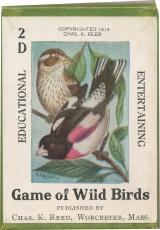Game of Wild Birds and Game of Wild Flowers


| Game of Wild Birds |
1914 |
Game of Wild Flowers |
 |
 |
In April 1903, in the magazine “American Ornithology,” the card game on birds “Game of Wild Birds” was mentioned for the first time.
The card game was offered as a gift to new subscribers or people who brought new subscribers to the magazine. Later, the card game was retailed at $0.35.
Even though nothing indicated that Chester A. Reed had produced the drawings at the time, it would be surprising if he didn’t. Chester also probably came up with the concept of the game. He was a teacher and probably contributed in defining the game’s rules.
Charles K. Reed only acquired a copyright for “Game of Wild Birds” and “Game of Wild Flowers” in October 1914. All drawings were printed using the 4-Color Process and signed by Chester A. Reed.
It is odd that there is no mention of Chester on the cover page of the card games.
Both games were meant for playing but, in 1914, the games were also used as advertising tools for Chester A. Reed’s books. In both cases, the small leaflet containing the rules recommended using Chester’s books as aide-memoires or references to fully enjoy the game.
The game includes 52 cards divided in 11 bird families. Two families had eight species each and nine families had four species each.
The winner is the person with the highest number of families and the highest number of bird species for each family.
Here is the “Photo Gallery” for this card game. . The first picture is the ad published in the magazine “American Ornithology” in April 1903.
The game includes 52 cards grouped by similar colors in twelve families, not by scientific classification. The first family includes eight species. The other families include five species each. The winner is the person with the highest number of families and the highest number of flower species for each family.
Most of the drawings in this card game were also used in a collection of 50 postcards published by Charles K. Reed between 1915 and 1916.